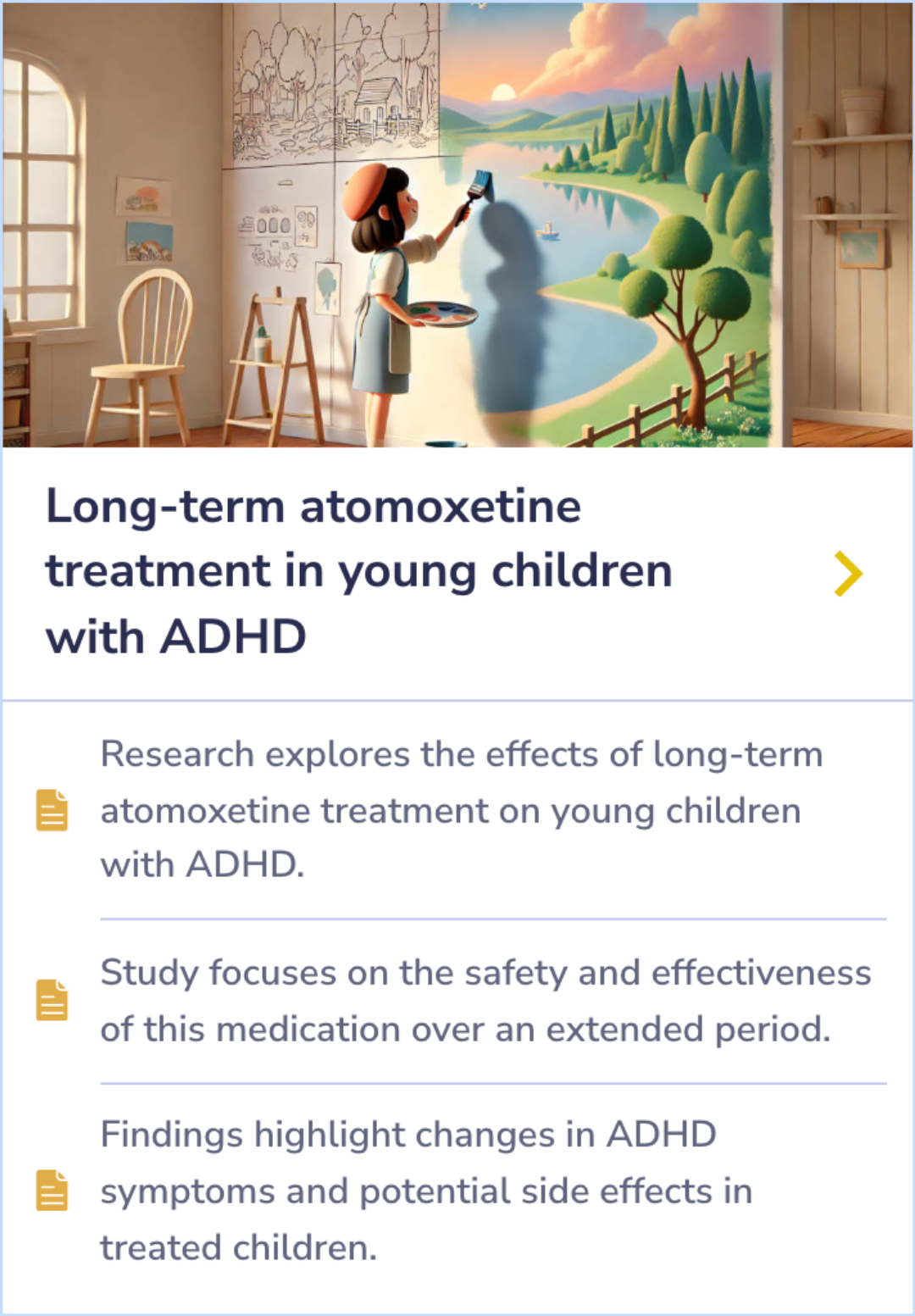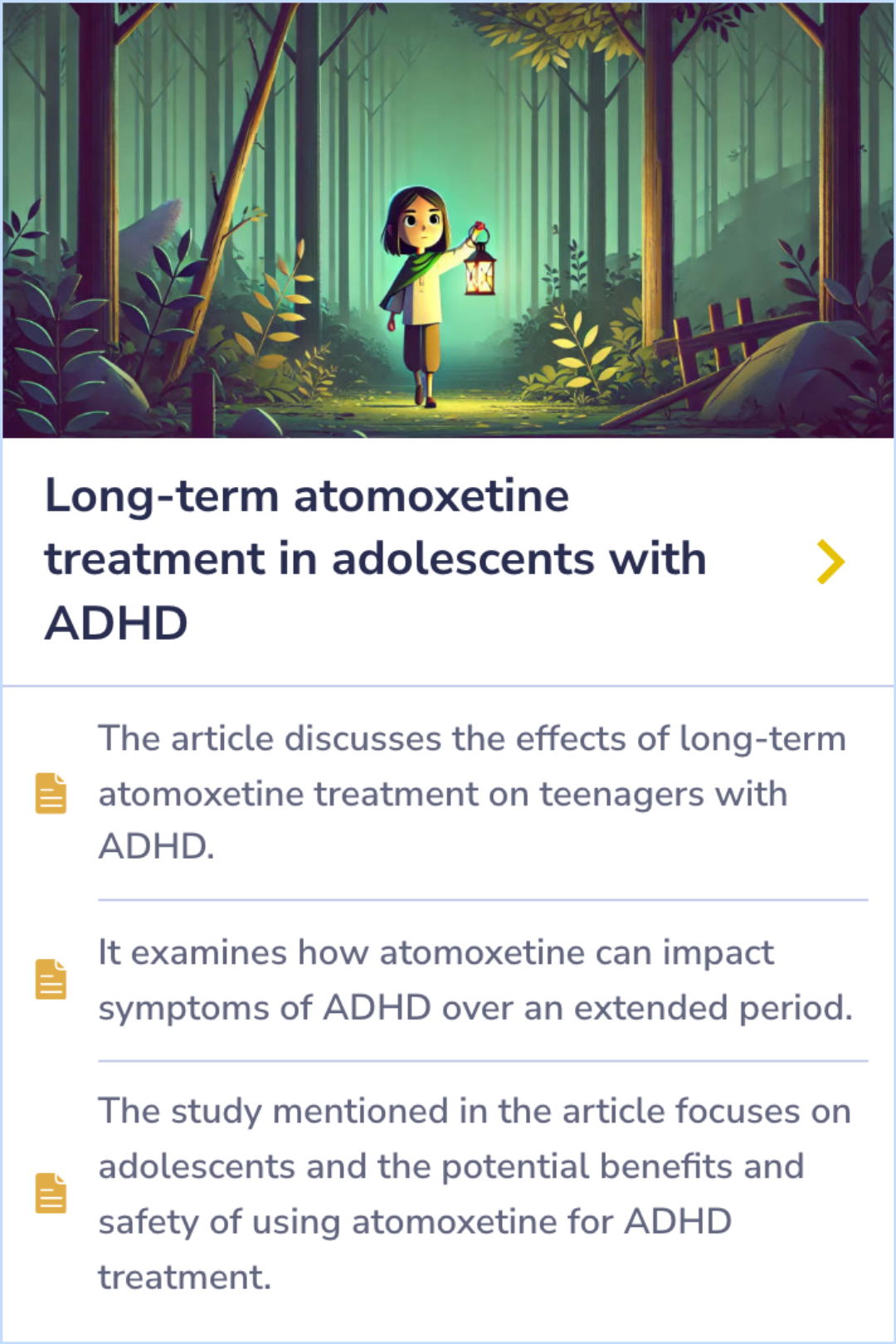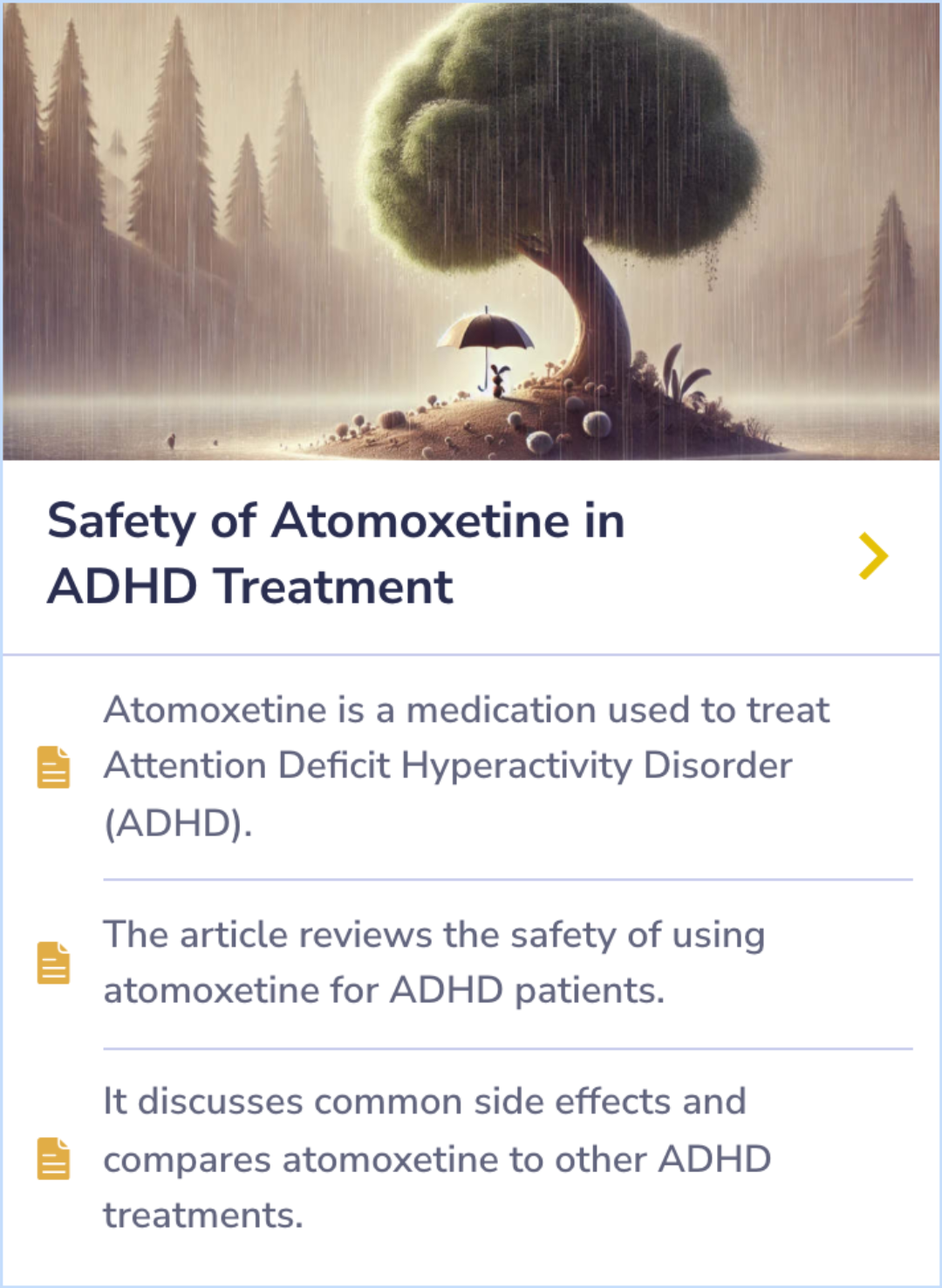Strattera
Evidence Based Answers
What are the long-term effects of Atomoxetine on growth in children and adolescents with ADHD?
Published: September 25, 2024
Studies Summary
⏳
Early Growth Impact of Atomoxetine
In the first 9-12 months of atomoxetine treatment, children may grow slower than peers, needing careful monitoring by healthcare providers.
📈
Long-Term Growth Recovery
By the third year of treatment, most patients’ height and weight return to expected patterns, but recovery varies with factors like pubertal status.
⚖️
Metabolism's Role in Growth
Growth outcomes vary based on metabolizer status; poor metabolizers may experience more delays, but overall patterns are similar.
Highly Cited Studies
Long term Effects of Methylphenidate in Adults
Peer Reviewed Study 1
Atomoxetine's Long-Term Impact on Growth in ADHD Patients
Peer Reviewed Study 2
Atomoxetine's Impact on Growth Over Two Years in Adolescents with ADHD
Peer Reviewed Study 3
Long-Term Growth Effects of Atomoxetine in Children with ADHD
Background: Growth Changes in Early Strattera Treatment
During the first 9 to 12 months of Strattera treatment, children and adolescents may experience slower growth compared to their peers.
This period is often marked by a delay in weight and height gain according to population data.
This period is often marked by a delay in weight and height gain according to population data.
“
Source Quotes:
In general, the weight and height gain of pediatric patients treated with STRATTERA lags behind that predicted by normative population data for about the first 9-12 months of treatment.
Atomoxetine may slow down children's growth or weight gain. Your child's doctor will probably monitor your child carefully during his or her treatment with atomoxetine.
Background: Long-Term Growth Patterns with Strattera
Strattera treatment may initially slow growth, particularly in the first year.
However, most patients see a return to typical growth patterns by the third year, with height and weight measurements aligning more closely with baseline predictions.
However, most patients see a return to typical growth patterns by the third year, with height and weight measurements aligning more closely with baseline predictions.
“
Source Quotes:
After about 12 months, gain in height stabilizes, and at 3 years, patients treated with STRATTERA have gained 17.4 cm on average, 0.4 cm less than predicted by their baseline data.
Atomoxetine has also been linked to growth delays compared to expected trajectories in the first 1 to 2 years of treatment, with a return to expected measurements after 2 to 3 years of treatment, on average.
Background: Impact of Metabolizer Status on Growth
Metabolizer status, whether poor or extensive, can impact growth outcomes during Strattera treatment.
Poor metabolizers may experience more pronounced delays in growth compared to extensive metabolizers, although overall patterns remain similar.
Poor metabolizers may experience more pronounced delays in growth compared to extensive metabolizers, although overall patterns remain similar.
“
Source Quotes:
PMs treated for at least two years gained an average of 2.4 kg and 1.1 cm less than predicted, while EMs gained an average of 0.2 kg and 0.4 cm less than predicted.
Growth patterns during treatment with atomoxetine can vary depending on the child's metabolizer status, with more delays observed in poor metabolizers.
Peer Reviewed Study
Study: Atomoxetine's Long-Term Impact on Growth in ADHD Patients
The abstract discusses the potential impact of Atomoxetine on growth in children and adolescents with ADHD. It mentions that decreases in weight and height gain were observed, especially in patients who were initially above average in weight and height. However, these reductions in growth appeared to recover over a period of 2-5 years with continued Atomoxetine treatment.
The data does not suggest lasting negative effects on growth, as patients tended to catch up over time.
The data does not suggest lasting negative effects on growth, as patients tended to catch up over time.
author
Reed VA, Buitelaar JK, Anand E, Day KA, Treuer T, Upadhyaya HP, Coghill DR, Kryzhanovskaya LA, Savill NC
journal
CNS Drugs
Date Published
2016 Jul
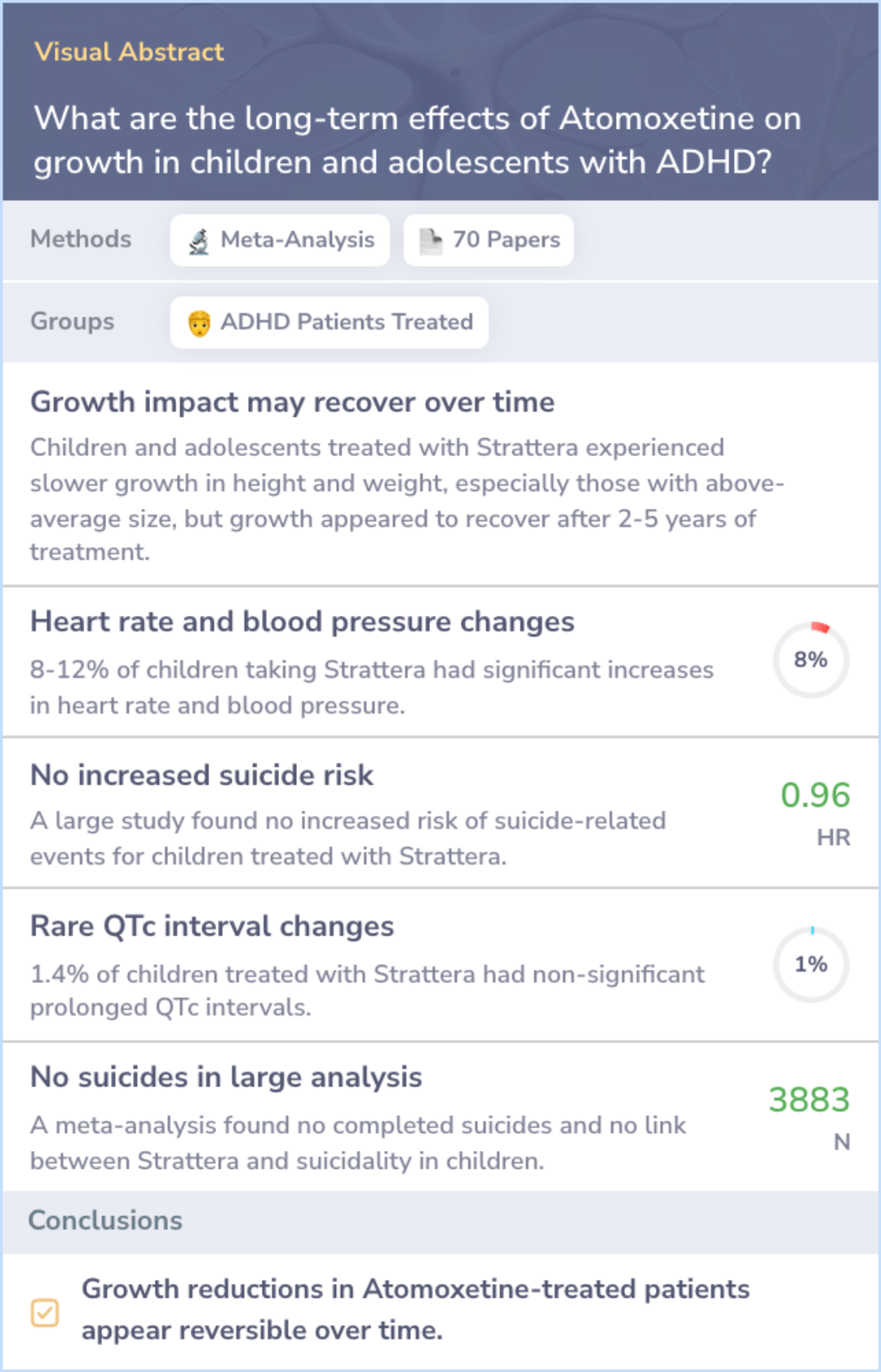
Peer Reviewed Study
Study: Atomoxetine's Impact on Growth Over Two Years in Adolescents with ADHD
This study pooled data from 13 studies on adolescents with ADHD treated with Atomoxetine for up to 2 years. Out of 601 subjects, 537 completed 3 months of treatment, and 219 completed at least 2 years. During this time, there were no clinically significant changes in height, weight, blood pressure, or other key health measures.
These findings suggest that long-term treatment with Atomoxetine in adolescents with ADHD does not negatively impact growth or other health parameters.
These findings suggest that long-term treatment with Atomoxetine in adolescents with ADHD does not negatively impact growth or other health parameters.
author
Wilens TE, Newcorn JH, Kratochvil CJ, Gao H, Thomason CK, Rogers AK, Feldman PD, Levine LR
journal
J Pediatr
Date Published
2006 Jul
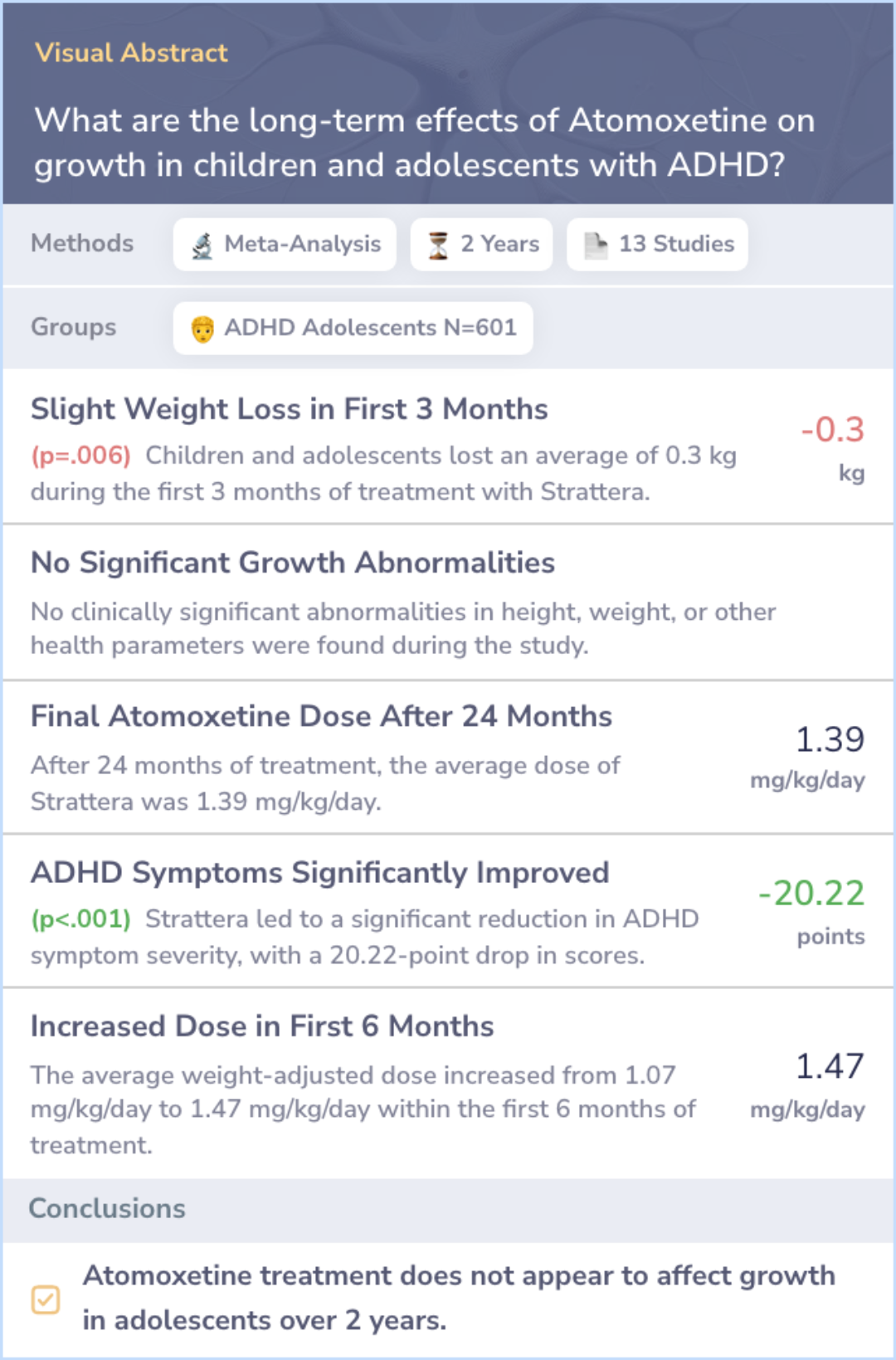
Peer Reviewed Study
Study: Long-Term Growth Effects of Atomoxetine in Children with ADHD
This meta-analysis pooled data from 13 studies involving children aged 6-7 with ADHD who received Atomoxetine for over 2 years. Growth effects were noted early on, but by the 2-year mark, these effects had decreased. While there were minor increases in pulse and blood pressure, no significant long-term growth issues were observed.
The findings suggest that Atomoxetine does not have a significant negative impact on long-term growth when used to treat ADHD in children.
The findings suggest that Atomoxetine does not have a significant negative impact on long-term growth when used to treat ADHD in children.
author
Kratochvil CJ, Wilens TE, Greenhill LL, Gao H, Baker KD, Feldman PD, Gelowitz DL
journal
J Am Acad Child Adolesc Psychiatry
Date Published
2006 Aug
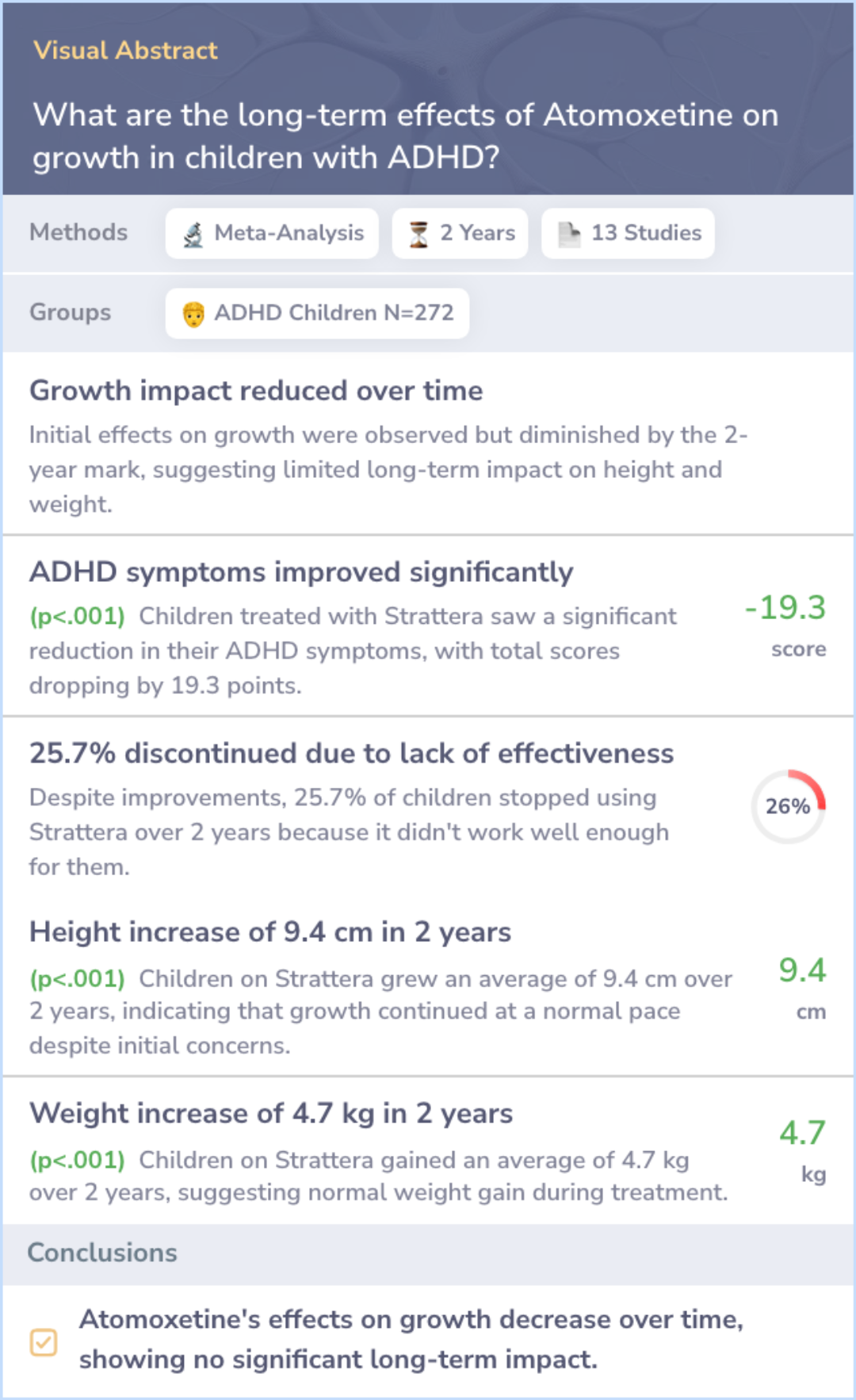
Key Takeaways
Conclusions
Atomoxetine, used for treating ADHD in children and adolescents, may initially slow growth within the first 9 to 12 months, leading to height and weight deficits compared to peers. However, long-term studies show that many patients' growth patterns align with or return to expected baselines by the third year of treatment. Variations exist based on developmental stages and individual metabolic rates, with pre-pubertal children and poor metabolizers experiencing more pronounced delays. Regular monitoring is vital to manage early impacts and aid long-term growth recovery, ensuring personalized guidance throughout the treatment process.
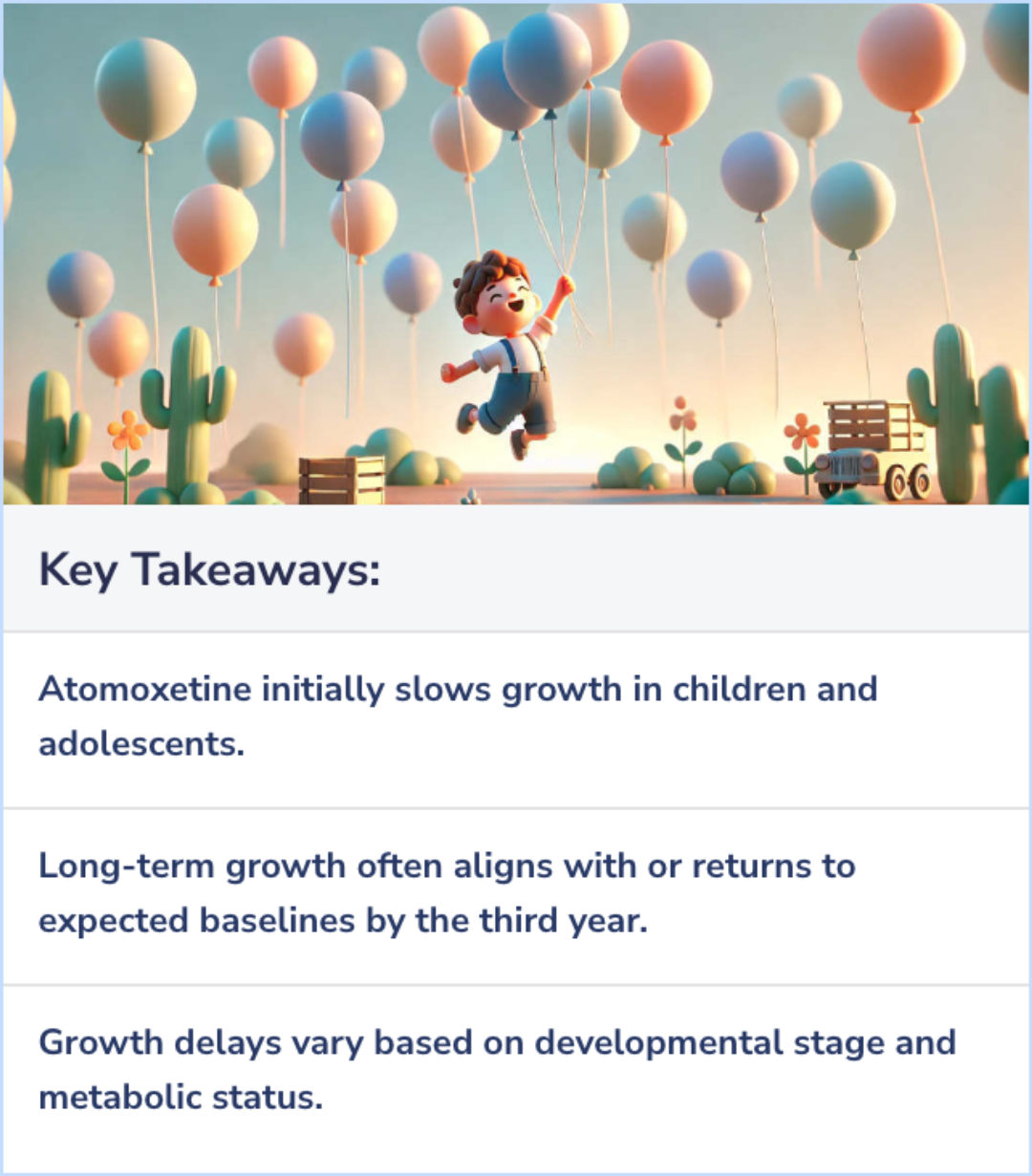
Evidence Summary
Tracking Atomoxetine's Long-Term Safety and Effectiveness in ADHD
This article examines how long-term atomoxetine treatment impacts young children with ADHD, focusing on both safety and effectiveness. The study tracks changes in symptoms and side effects to understand the medication's overall impact.
Researchers explore how atomoxetine affects children with ADHD over time, emphasizing safety and symptom changes. The focus is on tracking symptom improvements and potential side effects over an extended period.
Findings note alterations in ADHD symptoms and possible side effects for children undergoing treatment.
Researchers explore how atomoxetine affects children with ADHD over time, emphasizing safety and symptom changes. The focus is on tracking symptom improvements and potential side effects over an extended period.
Findings note alterations in ADHD symptoms and possible side effects for children undergoing treatment.
Evidence Summary
Long-Term Effects of Strattera on ADHD Symptoms in Adolescents
Prolonged Strattera use in adolescents with ADHD is explored, focusing on its effects over time. The content specifically examines how this medication influences ADHD symptoms during extended treatment.
It also discusses the safety and benefits of Strattera, highlighting its role in managing ADHD symptoms in teenagers over the long term.
The study emphasizes the medication's impact and safety profile for adolescent patients.
It also discusses the safety and benefits of Strattera, highlighting its role in managing ADHD symptoms in teenagers over the long term.
The study emphasizes the medication's impact and safety profile for adolescent patients.
Evidence Summary
Comparing Atomoxetine's Safety and Side Effects with Other ADHD Medications
Atomoxetine, a medication for ADHD, is reviewed for its safety profile. The text highlights common side effects and compares them to those of other ADHD medications. This exploration offers a detailed look at atomoxetine as an option for those considering treatment.
The article also compares atomoxetine to other ADHD treatments, providing context for how it measures up against other options in terms of safety and effectiveness.
The article also compares atomoxetine to other ADHD treatments, providing context for how it measures up against other options in terms of safety and effectiveness.
